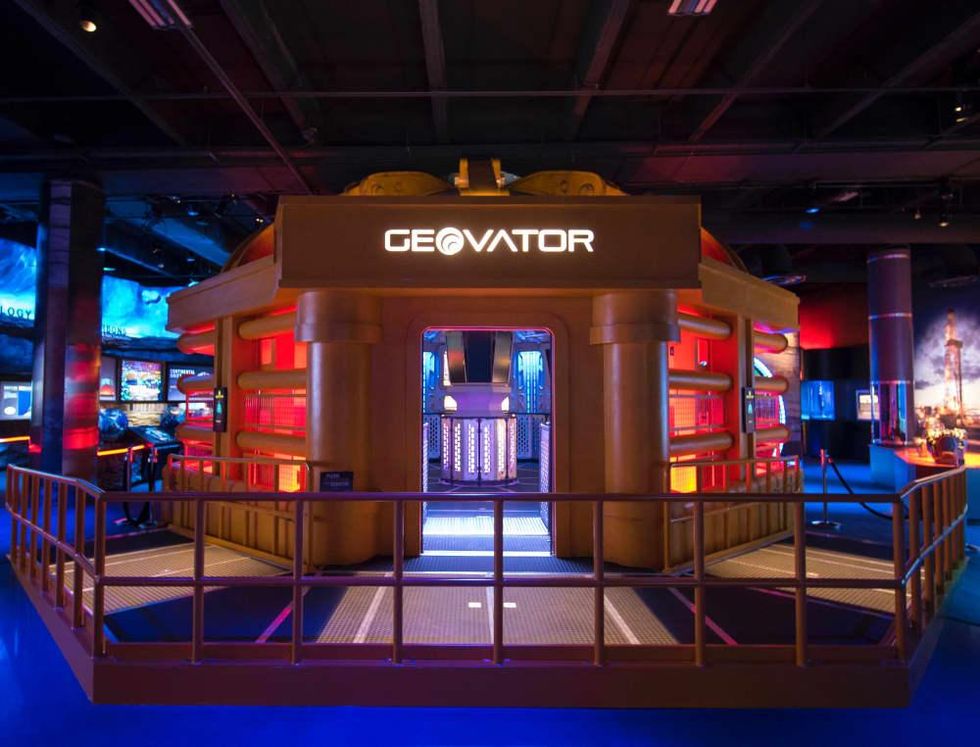The Houston Museum of Natural Science has always strived to make science fun for young and mature alike, but now with their newly reopened Wiess Energy Hall 3.0, they’ve managed to turn learning about energy science into a thrill ride.
Yes, the redesigned permanent Hall provides enough educational exhibits and interactive-learning displays to make the sternest high school physics and geology teachers giddy, but the HMNS has also built motion effects simulator rides into the exhibition, allowing visitors to fly, dive and drop directly in the never-ending story of how we discover and harness energy sources to power the world.
With an expansion from 8,500 square feet to 30,000 in this renovation and redesign of the popular exhibition, the HMNS seems almost modest in calling Wiess Hall “the most contemporary, comprehensive, technologically advanced exhibition on the science and technology of energy anywhere in the world.”
I recently had the opportunity to take a preview tour of Wiess Hall, where my energy journey began from the moment elevator doors opened on the 4th floor to reveal a wall-sized replica of an offshore drilling platform. But stepping deeper into the Hall, I felt like I had left a 21st-century museum and boarded the engine room of a favorite science fiction spaceship. The main difference from a Hollywood sci-fi movie set and the HMNS is that while some of the Wiess exhibits give peeks into future technology, much of the cutting edge science on display remains firmly grounded in the present–albeit sometimes 8,000 feet under said ground.
From floating satellites overhead to blinking displays on climate change to an interactive video simulator that allows visitors to feel they’re operating an offshore oil rig, Wiess Hall gives even the most hyperactive museum-goer plenty of hands-on exhibits to explore.
As a whole, the exhibition chronicles the different forms of energy systems and how we use that oil, gas, solar and wind power to fuel our cities and the very displays delivering all this energy knowledge to museum-goers. And while hydrocarbon fuel remains a large focus, renewable sources like wind and solar also become stars in the continuing energy technology story.
With much to do, see and learn, there’s enough to keep the most jaded kids and adult engaged, and perhaps awed, for hours by the science and technology, but I’d bet three big features in particular will likely lure Houstonians back again and again for continuing explorations.
Energy City
The greatest feast for the eyes comes from this 2,500-square-foot 3-D, 1/150th-scale “white model” of downtown Houston. This little H-Town uses projection mapping technology to create a vibrant constantly changing metropolitan and surrounding energy-harnessing landscape.
Energy City, which took two years to build and complete, becomes the stage for 30 minutes of animated content. A five minute sequence takes Houston from day to night and then each night brings the coolest science lecture ever, as 32 laser projectors paint a illustrated light story of how we power our lives using the many energy systems, including solar, nuclear, wind, hydroelectric and even geothermal. (Spoiler alert: watch out for volcanos.)
While Energy City educates on how we can access power from the Earth, sun, wind, and water, it also entertains with brilliant light shows and even fun little animated surprises during the daylight hours. Look closely for car chases and some unexpected space and time travelers.
EFX 3000 (The Eagle Ford Shale Experience)
Climb aboard this inner-space ship for a very active lesson on hydraulic fracturing. With curved projection techniques and mechanical motion effects, the simulated ride takes passengers on a bumpy flight–piloted by down-home Texan robot DAR-C–to Karnes County, Texas. Once we reached the gas and oil drilling fields a resident scientist shrinks the EFX 3000 down to miniature size, all the better to navigate through a borehole of an oil well. (Kudos to ride designers and the HMNS for pumping from the Houston’s talented acting well when casting. I recognized our friendly fracking engineer and shrinkologist. as Catastrophic Theatre regular Karina Pal Montaño-Bowers.)
Geovator
HMNS members will probably remember an older version of this simulator ride in the previous incarnation of the Hall. The completely revamped Geovator, a geological exploration/time traveling vessel, and its holographic host, Captain Mercaptan, take riders deep into the Earth and then back through time to the Cretaceous Period. After dodging pteranodons and witnessing the meteor strike that killed all the pteranodons, we got down to the business of seeing how hydrocarbons form.
Wiess Hall 3.0 is now open. Entry to the permanent exhibition is included in a general admission ticket to the Houston Museum of Natural Science.


















